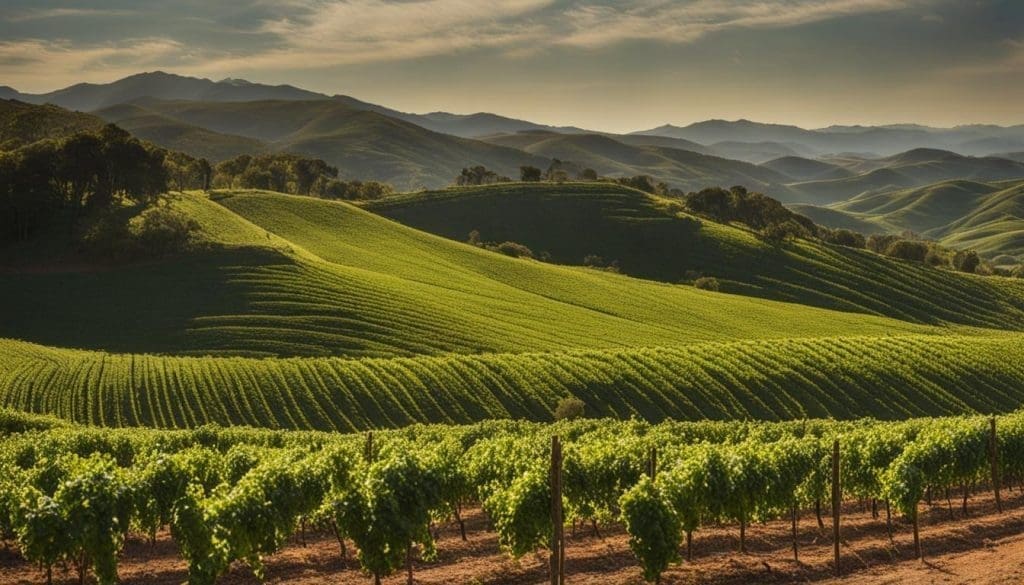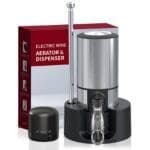This post may contain affiliate links. Please read my disclosure policy.
Malbec has established itself as Argentina’s flagship grape, offering a bold and robust experience. These red wines, with their jammy and juicy profiles, provide a taste sensation that includes robust tannins, lush fruit, and full-bodied flavours that persist. Often paired with steak or traditional Argentine Asado, Malbec acts as an inviting gateway to the essence of Mendoza’s wine culture. Gift sets featuring Malbec in elegant packaging highlight the value and appreciation of this grape variety for special occasions and celebrations.
Key Takeaways
- Malbec has become synonymous with Argentine wine, as the red grape variety thrives in the country’s vineyards.
- Characterised by its full-bodied flavour profile, Malbec offers a rich and bold wine experience.
- Typical Malbec wines showcase robust tannins, lush fruit, and lasting flavours, making them a popular choice for wine enthusiasts.
- Often enjoyed with traditional Argentine cuisine, Malbec complements various dishes, including steak and Asado.
- Gift sets featuring Malbec wine can be a thoughtful option for special occasions and celebrations, due to the importance and appreciation of the grape variety in Argentina.
An Introduction to the Malbec Grape Variety
When it comes to the world of wine, the Malbec grape variety holds a special place in enthusiasts’ hearts due to its rich profile, intense flavours, and low acidity. These features can be attributed to its cultivation in the high altitudes of Luján de Cuyo and Uco Valley in Mendoza, Argentina, which provide the ideal conditions for growing this distinct grape.
Beyond Argentina, Malbec grapes have also been successfully produced in other parts of the world, such as Malbec South Africa. However, the Argentine variant remains unparalleled in terms of flavour and recognition.
Malbec is not only a delight to the palate but also serves as a captivating centrepiece in gift baskets that couple the wine with an assortment of complementary edibles like cheeses, crackers, cookies, and candies.
Throughout its journey from its native France to Argentina and beyond, Malbec has continued to enthrall winemakers and wine lovers alike. This grape variety’s inherent charm is rooted in its versatility, elegance, and complexity, making it a standout choice among red wines.
Wine production techniques and winemaking philosophies may vary from one region to another, but the pursuit of excellence in cultivating Malbec grapes remains a common goal. Below is a table representing different regions and their unique approaches to Malbec cultivation:
| Region | Altitude | Climate | Soil |
|---|---|---|---|
| Mendoza, Argentina | 900-1200m | Semi-arid, continental | Alluvial, rocky |
| South Africa | 100-250m | Mediterranean | Granite, sandstone |
As we explore further the captivating world of Malbec and appreciate the passion and dedication that winemakers pour into every bottle, it becomes clear why this grape variety continues to captivate the palates and imaginations of wine lovers across the globe.
Exploring the Rich Profile and Primary Flavours of Malbec
Malbec wines are loved for their harmonious balance between sweetness and acidity, coupled with substantial tannin content that contributes to their full-bodied structure. This equilibrium results in a wine that manages to express ripe fruit tones while maintaining a palate-friendly freshness. In this section, we delve into the profile of Malbec grape variety, exploring the primary flavours of Malbec, sweetness level, acidity, tannins, and body.
Sweetness, Acidity, and Tannin Balance
Malbec wines generally have a medium to high sweetness level, which is perfectly balanced by their moderate acidity. This balance is crucial in ensuring that the wines remain approachable, without being overwhelming or excessively sweet. The tannins in Malbec also play a significant role in maintaining this balance, providing structure and giving the wine a pleasantly dry finish.
The harmonious balance between sweetness, acidity, and tannins allows Malbec wines to express ripe fruit tones while maintaining a palate-friendly freshness.
The Full-bodied Nature of Malbec Wine
The body of Malbec wines is another hallmark of the Malbec grape variety, as it boasts a full-bodied nature. This quality is achieved through the grape’s ripe fruit and the subsequent flavour density during the winemaking process. The full-bodied nature of Malbec wines is a key attribute that defines their typical taste profile and appeals to enthusiasts and casual drinkers alike.
Distinctive Taste Characteristics and Flavour Notes
Malbec is renowned for its distinctive taste characteristics and flavour notes, usually exuding a fruity aroma reminiscent of cherries or plums. The depth of these flavours can present a range from the subtle and elegant to the more robust and complex, catering to varied palates and occasions.
| Taste Characteristic | Description |
|---|---|
| Fruity Aroma | Malbec wines typically feature a fruity aroma with bold notes of cherries, plums, and other dark fruits. |
| Subtle and Elegant Flavours | Some Malbec wines offer subtle and elegant flavours, perfect for those who prefer a more refined taste experience. |
| Robust and Complex Flavours | Other Malbec wines showcase robust and complex flavours that captivate the palate and provide a memorable tasting experience. |
In conclusion, the distinctive taste characteristics and flavours of Malbec are one of the many reasons this grape variety is adored the world over. From its harmonious balance of sweetness, acidity, and tannins, to its full-bodied nature and unique flavour notes, Malbec wines provide a rich and satisfying experience for wine lovers.
The Terroir’s Influence: How Soil and Climate Shape Malbec
The quality and expression of Malbec grapes are profoundly influenced by the terroir, where the soil composition and climate conditions of Argentina, particularly in regions like Mendoza, facilitate ripe, intensely-flavoured grapes with a distinctive character that is hard to replicate elsewhere. In this section, we delve into the essential factors that contribute to the unique characteristics of Malbec grapes, such as the growing regions, climate, soil conditions, and regional influence on the grape variety.
Argentina is the largest wine producer in South America and the fifth-largest in the world. The majority of Argentine Malbec is grown in the Mendoza region, which boasts over two-thirds of the country’s vineyards. Other growing regions of Malbec include the areas of San Juan, La Rioja, Salta, and Patagonia. The geography of these regions, with their proximity to the Andes Mountains, is a crucial factor in defining the terroir needed for Malbec production.
Climate for Malbec
The climate for Malbec grape cultivation is predominantly semi-arid, with reliable sources of irrigation. Warm days and cool nights, combined with high altitude, contribute to the slow and even ripening process of the grapes. This climate results in a wine that showcases intense fruit flavours, well-balanced acidity, and noteworthy tannin structure.
Soil Conditions for Malbec
Soil conditions for Malbec vary across the different growing regions. In the Mendoza area, soil composition typically consists of alluvial soil, with a mixture of sand, clay, and silt that provides good drainage. These soils, combined with the mountainous topography, play a vital role in developing the rich, concentrated flavours and deep colour for which Malbec is renowned.
Regional Influence on Malbec
Regional influence on Malbec is closely tied to variations in terroir across Argentina. As these aspects change from one region to another, subtle differences in taste and aroma may emerge, giving a sense of place to each wine. For instance, Malbecs from the Uco Valley tend to be slightly more acidic and possess a floral character, while those from Luján de Cuyo have a more fruity and jammy profile.
| Region | Altitude (meters above sea level) | Taste Profile |
|---|---|---|
| Mendoza | 700-1,500 | Fruity, plum, and black cherry notes |
| Uco Valley | 1,000-1,600 | Higher acidity, floral character |
| Luján de Cuyo | 900-1,100 | Jammy, ripe fruit flavours |
| San Juan | 600-1,350 | Black fruit and mineral tones |
| La Rioja | 1,200-1,800 | Spicy, complex notes |
| Salta | 1,500-2,000 | High acidity, intense colour |
| Patagonia | 200-500 | Elegant, red fruit flavours |
In conclusion, the soil composition and climate conditions of Argentina significantly impact the character of Malbec grapes. The terroir of the country, particularly in key regions like Mendoza, has facilitated the development of a wine grape variety that expresses a distinctive and intensely flavourful profile that showcases Argentina’s unique growing conditions.
Malbec’s History: From French Origins to Argentine Fame
The origin of Malbec traces back to the Cahors region of France, where it was initially known as ‘Côt’ and was grown in the picturesque vineyards of Bordeaux and the Loire Valley. In the early 19th century, Malbec found its way to Argentina’s fertile lands, a move that sparked a transformational era of the grape’s history.

Evolution of Malbec in Argentina’s Vineyards
Over the years, the cultivation of Malbec grapes in Argentina led to a wonderful metamorphosis. The region’s unique terroir, characterized by high altitudes and warm, sunny days, greatly contributed to the evolution of Malbec grapes in the country. What was once a minor blending grape in France adapted to its new environment, eventually flourishing with underlying notes of bold fruit and plush tannins.
After recovering from the phylloxera epidemic that devastated major European vineyards in the late 19th century, Malbec witnessed overwhelming growth in its Argentine stronghold, especially in the wine sanctuary of Mendoza.
“Argentina breathed new life into Malbec and helped to create a wine profile that resonates globally with both connoisseurs and novices.”
The evolutionary journey of Malbec has not gone unnoticed, as numerous esteemed wineries have dedicated themselves to refining and perfecting this grape variety. Brands like Catena Zapata, Bodega Norton, and Trapiche have garnered international recognition for their exceptional Malbec wines.
| Year | Significant Event |
|---|---|
| 18th Century | Malbec thrives as ‘Côt’ in the Bordeaux and Loire Valley regions of France. |
| Early 19th Century | Malbec arrives in Argentina, initiating a new chapter in its history. |
| Late 19th Century | Phylloxera wreaks havoc on European vineyards; Malbec finds respite in Argentina. |
| 20th Century to Present | Wineries in Argentina focus on perfecting Malbec, earning worldwide recognition. |
In conclusion, the fascinating history of Malbec is proof of its adaptability and versatility. The background of the Malbec grape is one that showcases how a seemingly minuscule component of France’s winemaking heritage transformed into a flagship variety for Argentine wine – a symbol of pride and a testament to the country’s passion for viticulture.
Tasting, Serving and Enjoying Malbec
When enjoying a glass of Malbec, it is essential to consider multiple aspects to fully appreciate all it has to offer. A few notable considerations include the serving temperature, glass type, decanting time, aeration, ageing, and food pairings.
A critical element to elevate the tasting experience of Malbec is the serving temperature. The ideal temperature in Celsius for Malbec is 16-18°C (60-64°F), a temperature range that allows the bold flavours to shine and the wine’s aroma to be fully expressed.
Temperature impact on Malbec can greatly affect your enjoyment of the wine. If served too cold, the wine can become tight and muted, whereas serving it too warm can lead to an overly alcoholic and unbalanced taste profile.
While most may quickly overlook the importance of glassware for Malbec, it can significantly elevate one’s tasting experience. The recommended glass type for Malbec is an ample red wine glass with a broad bowl, which allows the wine to breathe and releases its complex aroma profile. This choice of glassware also directs the wine to the appropriate part of the palate to accentuate the lush fruitiness and velvety texture.
Another contributing factor to the enjoyment of Malbec is decanting. Decanting time for Malbec can range from 30 minutes to 2 hours, depending on the specific wine and its age. The decanting impact on Malbec can include enhancement of the wine’s bouquet, softening of the tannic structure, and increased exposure to aeration, which helps the wine to evolve and reveal its intricate flavour nuances.
Aeration for Malbec can be a significant factor in improving the drinking pleasure, particularly for young, tannic, or densely fruited wines.
As with many fine wines, ageing of Malbec can result in added complexity and depth of flavour. Depending on the wine and its provenance, one might decide to drink Malbec now or age it for a few years. Ageing impact on Malbec can include greater integration of flavour components, increased aromatic complexity, and improved texture and mouthfeel.
The right food pairings with Malbec can create an unforgettable gastronomic delight, bringing out the best in both the wine and the cuisine. Some classic cuisine match for Malbec includes grilled or roasted meats, such as beef, lamb, or pork, along with flavourful, spicy dishes and hearty stews. In addition to its versatility in wine and food pairing for Malbec, experimenting with various combinations can genuinely enhance your appreciation of this exceptional grape variety.
- Factors affecting the Malbec wine tasting experience:
- serving temperature
- choice of glassware for Malbec
- decanting time and impact on Malbec
- aeration considerations
- ageing potential and impact on taste
- food pairings and cuisine match
In summary, to truly relish the delectable flavours of Malbec, one must pay attention to serving temperature, glass type, decanting, aeration, and ageing. As a wine with diverse compatibility in terms of gastronomy, Malbec’s excellence lies in its exquisite taste profile, which allows food pairing creativity and offers a satisfying culinary adventure.
Conclusion
In summary, Malbec has emerged as a glorious gift from Argentina, exemplifying the country’s unique terroir and the talent of its winemakers. Wine enthusiasts across the globe are captivated by the variety’s distinctive taste profiles, fascinating history, and impressive adaptability. Its inherent flexibility and appealing characteristics have earned Malbec a prestigious place among the world’s top wines.
Argentina’s commitment to refining Malbec’s cultivation and production techniques has led to the establishment of numerous notable wineries that celebrate the grape’s exceptional qualities. These wineries dot the landscape of Argentina’s famed wine regions, drawing wine lovers to partake in memorable wine tasting experiences and witness the magic of Malbec unfurl before their very eyes.
At the heart of Malbec’s worldwide appeal is its ability to inspire connection, appreciation, and discovery. As each bold and vibrant sip fills the senses, it provides a lively reminder of Argentina’s remarkable contribution to the world of wine and solidifies Malbec’s enduring legacy as a beloved grape variety cherished by connoisseurs and casual drinkers alike.
FAQ
What are the primary flavours of Malbec?
Malbec is known for its depth of flavours including fruity aromas reminiscent of cherries or plums. The taste characteristics can range from subtle and elegant to robust and complex.
How does the terroir influence Malbec’s taste profile?
The terroir, including the soil composition and climate conditions, plays a significant role in shaping Malbec’s taste. In regions like Mendoza, Argentina, the terroir facilitates the cultivation of ripe, intensely-flavoured grapes, creating a distinctive character unique to the area.
What is the ideal serving temperature for Malbec?
Malbec is best enjoyed at a temperature between 16-18 degrees Celsius (60-64 degrees Fahrenheit). This range accentuates its flavours and provides a better tasting experience.
Do I need to decant Malbec before serving?
Decanting Malbec can enhance the wine’s bouquet and softness, but it is not always necessary. If you choose to decant, a brief period of aeration is generally sufficient to elevate the taste.
Should Malbec be consumed immediately or aged?
Malbec can be enjoyed immediately or aged for added complexity. Its ageing potential and impact on taste demonstrate Malbec’s versatility as a wine that suits various preferences and occasions.
What food pairs well with Malbec?
Malbec is often paired with red meat, such as steak, or traditional Argentine Asado. It also complements an assortment of cheeses, crackers, cookies, and candies, making it a suitable pairing for various cuisines and dining experiences.
Unlocking the Mystery: What are Tannins in Wine?
Sip smarter, subscribe now!
Subscribe for gourmet tips, event updates, travel ideas, and a free e-book on Food Pairings. Start your journey to culinary and travel excellence!















